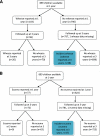The role of acetaminophen and geohelminth infection on the incidence of wheeze and eczema: a longitudinal birth-cohort study
- PMID: 20935107
- PMCID: PMC3040388
- DOI: 10.1164/rccm.201006-0989OC
The role of acetaminophen and geohelminth infection on the incidence of wheeze and eczema: a longitudinal birth-cohort study
Abstract
Rationale: Acetaminophen has been hypothesized to increase the risk of asthma and allergic disease, and geohelminth infection to reduce the risk, but evidence from longitudinal cohort studies is lacking.
Objectives: To investigate the independent effects of these exposures on the incidence of wheeze and eczema in a birth cohort.
Methods: In 2005-2006 a population-based cohort of 1,065 pregnant women from Butajira, Ethiopia, was established, to whom 1,006 live singleton babies were born. At ages 1 and 3, questionnaire data were collected on wheeze, eczema, child's use of acetaminophen, and various potential confounders, along with a stool sample for geohelminth analysis. Those without wheeze (n = 756) or eczema (n = 780) at age 1 were analyzed to determine the independent effects of geohelminth infection and acetaminophen use in the first year of life on the incidence of wheeze and eczema by age 3.
Measurements and main results: Wheeze and eczema incidence between the ages of 1 and 3 were reported in 7.7% (58 of 756) and 7.3% (57 of 780) of children, respectively. Acetaminophen use was significantly associated with a dose-dependent increased risk of incident wheeze (adjusted odds ratio = 1.88 and 95% confidence interval 1.03-3.44 for one to three tablets and 7.25 and 2.02-25.95 for ≥ 4 tablets in the past month at age 1 vs. never), but not eczema. Geohelminth infection was insufficiently prevalent (<4%) to compute estimates of effect.
Conclusions: These findings suggest frequent acetaminophen use early in life increases the risk of new-onset wheeze, whereas the role of geohelminth infection on allergic disease incidence remains to be seen as the cohort matures.
Figures
Comment in
-
The acetaminophen enigma in asthma.Am J Respir Crit Care Med. 2011 Jan 15;183(2):147-8. doi: 10.1164/rccm.201007-1135ED. Am J Respir Crit Care Med. 2011. PMID: 21242591 No abstract available.
-
Acetaminophen and asthma: spurious association?Am J Respir Crit Care Med. 2011 Jun 1;183(11):1570; author reply 1570-1. doi: 10.1164/ajrccm.183.11.1570. Am J Respir Crit Care Med. 2011. PMID: 21642259 No abstract available.
References
-
- Eder W, Ege MJ, von Mutius E. The asthma epidemic. N Engl J Med 2006;355:2226–2235. - PubMed
-
- Asher MI, Montefort S, Bjorksten B, Lai CK, Strachan DP, Weiland SK, Williams H. Worldwide time trends in the prevalence of symptoms of asthma, allergic rhinoconjunctivitis, and eczema in childhood: ISAAC Phases One and Three repeat multicounty cross-sectional surveys. Lancet 2006;368:733–743. - PubMed
-
- Leonardi-Bee J, Pritchard D, Britton J; Parasites in Asthma Collaboration. Asthma and current intestinal parasite infection: systematic review and meta-analysis. Am J Respir Crit Care Med 2006;174:514–523. - PubMed
Publication types
MeSH terms
Substances
Grants and funding
LinkOut - more resources
Full Text Sources
Medical
Miscellaneous


